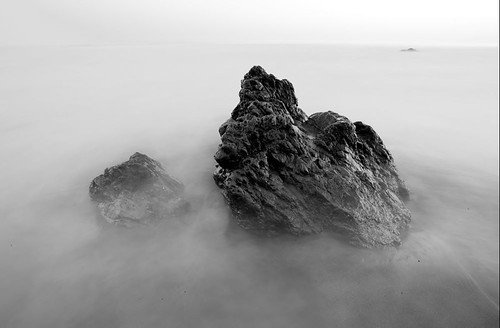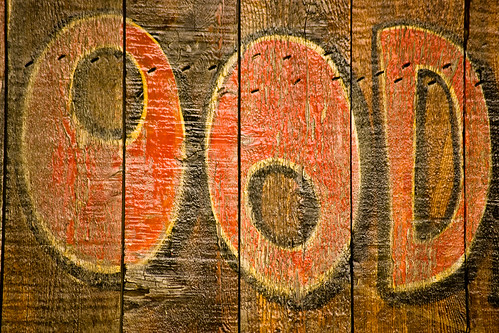Saturday, June 28, 2008
Thursday, June 26, 2008
shining eyes on one buttock
There's a lot of classical photography I don't get. Much of the sort of images that are hailed as old masters in the art leave me mostly cold. Largely, I think that's because I lack the historical context to realise how radically different they might have been at the time. Michael Johnston takes people to task in passing who say this about William Eggleston in this blog post. I feel that's a good example of what I mean. The context he describes suddenly makes it all make sense - I just didn't know enough beforehand to recognise why it might be interesting. Looking backwards, it looks just like everything else that went after. Another good example is the Steerage by Steiglitz. I've seen it several times before, but it wasn't until I got context for the image from one of Jeff Curto's great photographic history lectures that I could understand why that fairly pedestrian composition was so radical for its time. the context he provided made the image make sense.
In this great TED talk, Benjamin Zander provides context for classical music in a way that I haven't experienced before. There is maybe something to consider in there about looking at bodies of work of photography, rather than individual impulses or images as well. Even if you don't get any photographical inspiration I still think it is well worth the 20 minutes it'll take you to watch it. The parting thought is something to ponder for a while.
Posted by
Unknown
at
11:59 PM
2
comments
![]()
Labels: artists, creativity, inspiration
Tuesday, June 24, 2008
Thursday, June 19, 2008
photo expressions available from blurb
Tuesday, June 17, 2008
back to basics
 I talked to a friend at the weekend who works with a lot of alternative photographic processes and equipment. He has an eclectic array of different film and digital cameras and makes some beautiful images. This time he walked in with a large box under his arm. Proudly he showed off the prints he'd been making with this several foot square cardboard pinhole camera that he'd made. It was fascinating. The negatives were about 2 foot by 3 foot, made directly on photographic paper, through a small brass pinhole on the side of the box. He used a magnetic shutter (well, a thin fridge magnet) to make the box work and sealed it up at home prior to going out and shooting his one, large frame. The camera is the big green box in the shot below.
I talked to a friend at the weekend who works with a lot of alternative photographic processes and equipment. He has an eclectic array of different film and digital cameras and makes some beautiful images. This time he walked in with a large box under his arm. Proudly he showed off the prints he'd been making with this several foot square cardboard pinhole camera that he'd made. It was fascinating. The negatives were about 2 foot by 3 foot, made directly on photographic paper, through a small brass pinhole on the side of the box. He used a magnetic shutter (well, a thin fridge magnet) to make the box work and sealed it up at home prior to going out and shooting his one, large frame. The camera is the big green box in the shot below.
 He estimated that the pinhole was probably about an f256 aperture and the image was sharp right across the plane. There was a concave film holder at the back of the box (a flexed piece of card). The simplicity and elegance of the entire camera fascinates me, compared to the technical and electronic marvels that many of us use.
The shot at the top of this post is another of his images, this time taken with a pinhole camera made from a tin can. It isn't perfect, but there is a charm and character to the image that is absent from a lot of the technically perfect but less than exciting digital imagery that you can find around. More than that, there is a magic to it - a tin can and some light sensitive paper and a bit of chemistry and you end up with an image.
It reminded me of the room-sized camera obscura that is shown in one of the genius of photography episodes. A team rent a hotel room in Rome, across from a famous church. They black out the windows, install a small aperture as the only place that light can enter the room, then watch and wait until their eyes adjust and a perfect, beautiful, inverted and reversed image of the church across the street appears on the opposite wall. Magical. I've enjoyed similar effects from small holes in the window blinds in my bedroom, watching the early morning sun dance small images of the trees in the garden across the wall.
He estimated that the pinhole was probably about an f256 aperture and the image was sharp right across the plane. There was a concave film holder at the back of the box (a flexed piece of card). The simplicity and elegance of the entire camera fascinates me, compared to the technical and electronic marvels that many of us use.
The shot at the top of this post is another of his images, this time taken with a pinhole camera made from a tin can. It isn't perfect, but there is a charm and character to the image that is absent from a lot of the technically perfect but less than exciting digital imagery that you can find around. More than that, there is a magic to it - a tin can and some light sensitive paper and a bit of chemistry and you end up with an image.
It reminded me of the room-sized camera obscura that is shown in one of the genius of photography episodes. A team rent a hotel room in Rome, across from a famous church. They black out the windows, install a small aperture as the only place that light can enter the room, then watch and wait until their eyes adjust and a perfect, beautiful, inverted and reversed image of the church across the street appears on the opposite wall. Magical. I've enjoyed similar effects from small holes in the window blinds in my bedroom, watching the early morning sun dance small images of the trees in the garden across the wall.
 We also got to talking about various larger sized camera obscura and one image stood out as particularly whimsical. He mentioned someone who sensitises paper across the entire back side of a large pin-hole camera then is actually inside the box during the exposure, dodging and burning the image as it is formed, from inside the camera. Using their whole body to block and shape the light hitting the paper. It just seems such a wonderfully organic way to interact with the print that I'm fascinated. Perhaps even more so because I've never even experienced the basic process of printing a black and white image in a darkroom - something I want to try, before it all disappears.
We also got to talking about various larger sized camera obscura and one image stood out as particularly whimsical. He mentioned someone who sensitises paper across the entire back side of a large pin-hole camera then is actually inside the box during the exposure, dodging and burning the image as it is formed, from inside the camera. Using their whole body to block and shape the light hitting the paper. It just seems such a wonderfully organic way to interact with the print that I'm fascinated. Perhaps even more so because I've never even experienced the basic process of printing a black and white image in a darkroom - something I want to try, before it all disappears.
Posted by
Unknown
at
10:22 AM
3
comments
![]()
Labels: artists, creativity, design, process
another myth of talent
Posted by
Unknown
at
8:37 AM
2
comments
![]()
Labels: "myth of talent", books, creativity
Monday, June 16, 2008
Behind the Gare Saint-Lazare

Posted by
Unknown
at
5:04 PM
0
comments
![]()
Labels: creativity, geeky, process
Sunday, June 15, 2008
last weekend
Posted by
Unknown
at
11:17 AM
1 comments
![]()
Labels: California
Thursday, June 12, 2008
citadel
Posted by
Unknown
at
9:43 AM
0
comments
![]()
Wednesday, June 11, 2008
Happy Birthday Amanda!

Posted by
Unknown
at
9:15 AM
3
comments
![]()
Labels: amanda, California, water
Wednesday, June 04, 2008
where does creativity hide?
How does string theory and quantum mechanics tie in to creativity? Amy Tan explains. Hopefully this provides enough physics to keep Paul Butzi happy. Elucubrate enough and you can find the links between everything. Particularly interesting is the notion how everything you experience informs your creativity - I wouldn't have paid as much attention to this if Paul hadn't made his off-hand remarks about my earlier post, for example. Wheels within wheels. Serendipitous events happen more often the more aware and open you are to them happening, or at least how willing you are to stop and follow those chance events, rather than ignore or discount them. Much like the cosmological constant.
Posted by
Unknown
at
10:46 PM
3
comments
![]()
Labels: creativity
Tuesday, June 03, 2008
Citizenship tests
Seems you can tell a lot about a country by what you have to know to be a citizen. Looked at the Australian, British and American tests last night. The American's are very into this whole democracy thing. All the questions are about the Constitution, branches of government, racial equality and native American rights. No filler. All very dour and serious. Apparently it is a very po-faced thing becoming an American citizen. Take it seriously! The only test that isn't multi-choice either.
- What are the three branches of our government?
- Who becomes President of the United States if the President and the Vice-President should die?
- Who was the main writer of the Declaration of Independence?
- When was the Declaration of Independence adopted?
- Which President was the first Commander in Chief of the U.S. military?
- What were the 13 original states?
- St Andrews, St Patrick's, St David's and St George's
- St David's, St Patrick's, St George's and St Andrews
- St George's, St Patrick's, St Andrews and St David's
- You would offer to buy the person another pint
- You would offer to dry their wet shirt with your own
- You may need to prepare for a fight in the car park
- The Mappa Mundi
- The Magna Carta
- The Bill of Rights
- Australia's England tour in 1930
- Australia's England tour in 1882
- Australia's England tour in 1948
- Cathy Freeman
- Phar Lap
- Sir Donald Bradman
- budgie smugglers, cossies, swimmers
- budgies cossers, toggie batties, swimmy budgers
- togs, bummies, sossies
- swommies, cossies, mugglers
Posted by
Unknown
at
7:53 AM
5
comments
![]()







